TechRadar Verdict
With the panels at the heart of almost all OLED TVs starting out the same, making an OLED TV stand out from the crowd chiefly boils down to a combination of design, features, audio performance, and image processing – all of which the Philips 65OLED805 excels at. With its Ambilight design, huge feature list, powerful processing and surprisingly potent sound, it ticks all the right boxes at a surprisingly competitive price point.
Pros
- +
Great value
- +
Excellent picture quality
- +
Lovely design and build quality
Cons
- -
Android TV isn’t the friendliest smart system
- -
Needs careful setup to get best results
- -
Image retention potential
Why you can trust TechRadar
Two-minute review
Despite costing a very reasonable £2,199, the 65-inch Philips OLED 805 isn’t quite the cheapest 65-inch OLED in town. That honour belongs to the LG BX OLED. However, Philips’ set offers some genuine step-up features, along with a premium, metal-backed design that includes a three-sided version of Philips’ unique Ambilight technology, all for significantly less than direct OLED rivals such as the Sony A8H or LG CX OLED.
The Philips OLED 805’s smart features are built around the latest (v9.0) Android smart TV system. This delivers a wealth of apps as usual, and is helpfully bolstered by the appearance of Freeview Play – and therefore catch-up apps of the UK’s key terrestrial broadcast services – which is often omitted on Android TVs. The built in Chromecast is always helpful, too.
Android TV can still feel unwieldy at times, though, and there’s no Apple TV app support.
The Philips OLED 805’s main performance advances over last year’s Philips OLED range include AI-based picture improvements, as well as revamped speakers that deploy larger mid-range speaker drivers and a new tweeter design.
Both of these improvements deliver strong results. Pictures are vivid, sharp and bright in keeping with Philips’ usual bold approach, but combine these eye-catching attractions with a more natural look and feel than the brand has historically achieved.
Audio playback – which includes built-in decoding of Dolby Atmos – is detailed, dynamic and clean, and breaks free of the physical confines of the TV without starting to sound brittle or incoherent.
There are one or two relatively small niggles with the Philips OLED 805’s picture – and as ever with OLED, it’s recommended that you use it with care, to reduce the potential for permanent image retention (or ‘burn-in’). Overall, though, its combination of price, design and performance deserve to see it make a real splash in this year’s ultra-competitive OLED TV market.
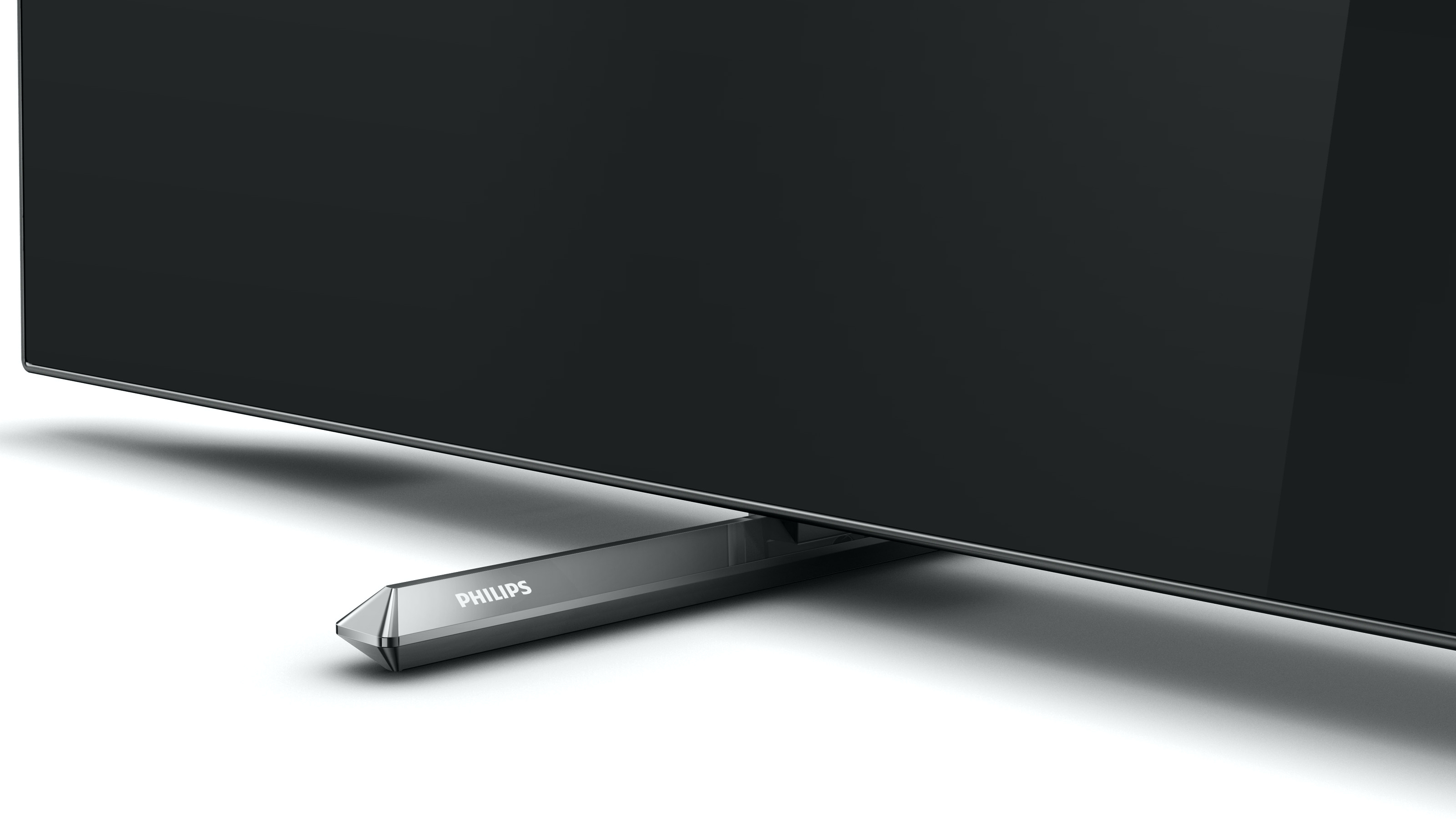
Price and availability
The 65OLED805 and its 55-inch sibling are both widely available in the UK. However, you won’t find them in the US, where the Philips TV brand name is owned by Funai.
Both OLED805 sizes are very aggressively priced at £2,199 and £1,499 respectively. The 65-inch price in particular comfortably undercuts most of the OLED competition. At the time of writing, the 65OLED805 is £300 cheaper than LG’s OLED65CX, £200 cheaper than the entry-level Panasonic HZ980, and £400 cheaper than Sony’s entry level KD-65A8. All of which looks all the more impressive when you realise how few compromises Philips has had to make with this set.
Screen Sizes: 55-, 65-inches | Tuner: Freeview HD | 4K: Yes | HDR: Yes | Panel technology: OLED | Smart TV: Yes, Android TV 9.0 | Curved: No | Dimensions: 1448.7(w) x 880.2(h) x 58(d)mm | Weight: 27.9kg | 3D: No | Inputs: 4xHDMI 2.0, 2xUSB, RF, optical digital audio, CI slot, headphone slot, Ethernet
Design
- Minimalistic frame and feet
- Ambilight can enhance immersion if handled carefully.
- Outstanding build quality
The outside of the Philips OLED 805 has a strong, minimalist design. The frame around its screen is remarkably slim, while its two feet are almost invisible when viewed straight on – especially as the screen sits right above them in the TV’s standard setup. Philips does thoughtfully provide a couple of little neck options, though, if you want to raise the screen slightly to fit a soundbar underneath.
The Philips OLED 805 draws more attention to itself when viewed up close, though, thanks to its exceptional build quality. From the silver metal backplate that supports the OLED film to the gorgeous polished chrome of the feet, it looks far more premium than its price would suggest.
It’s when you turn it on, though, that the Philips OLED 805’s design really springs to life, thanks to Philips’ Ambilight technology. This exclusive feature consists of an LED array mounted on the TV’s rear, casting out a wide pool of coloured light around the display – calibrating in response to the brightness and color content of what’s being shown onscreen.
Fun as it is in Philips’ aggressive default settings, I’d recommend toning Ambilight down to a relatively low brightness level and response speed to ensure it gently enhances the viewing experience rather than distracting from it.
Accompanying the gorgeously TV is a pretty remote control. It’s slim, elongated design and Muirhead leather finish feels really nice and balanced in your hand, and the buttons are all tastefully backlit.
The buttons are rather tightly packed together and a little small, but the layout is mostly logical, and the main navigation and select buttons are suitably prominent.
The Philips OLED 805’s connections include four HDMIs, two USBs and a digital optical audio output. A third USB might have been nice, but two can be considered enough for the Philips OLED 805’s price.
More of a pity is the inability of the Philips OLED 805’s HDMIs to support a number of potentially useful gaming features; namely, variable refresh rates, 4K playback at 120Hz, and automatic low latency mode switching.
Manually activating the set’s Game preset reduces input lag to around 33.1ms at least – though this is an average result by today’s standards.
The HDMIs also only support the standard audio return channel (ARC) system. So while they can pass lossy Dolby Atmos sound through the TV to an attached AV receiver or soundbar, they can’t pass through the lossless Atmos sound you get from 4K Blu-ray players.
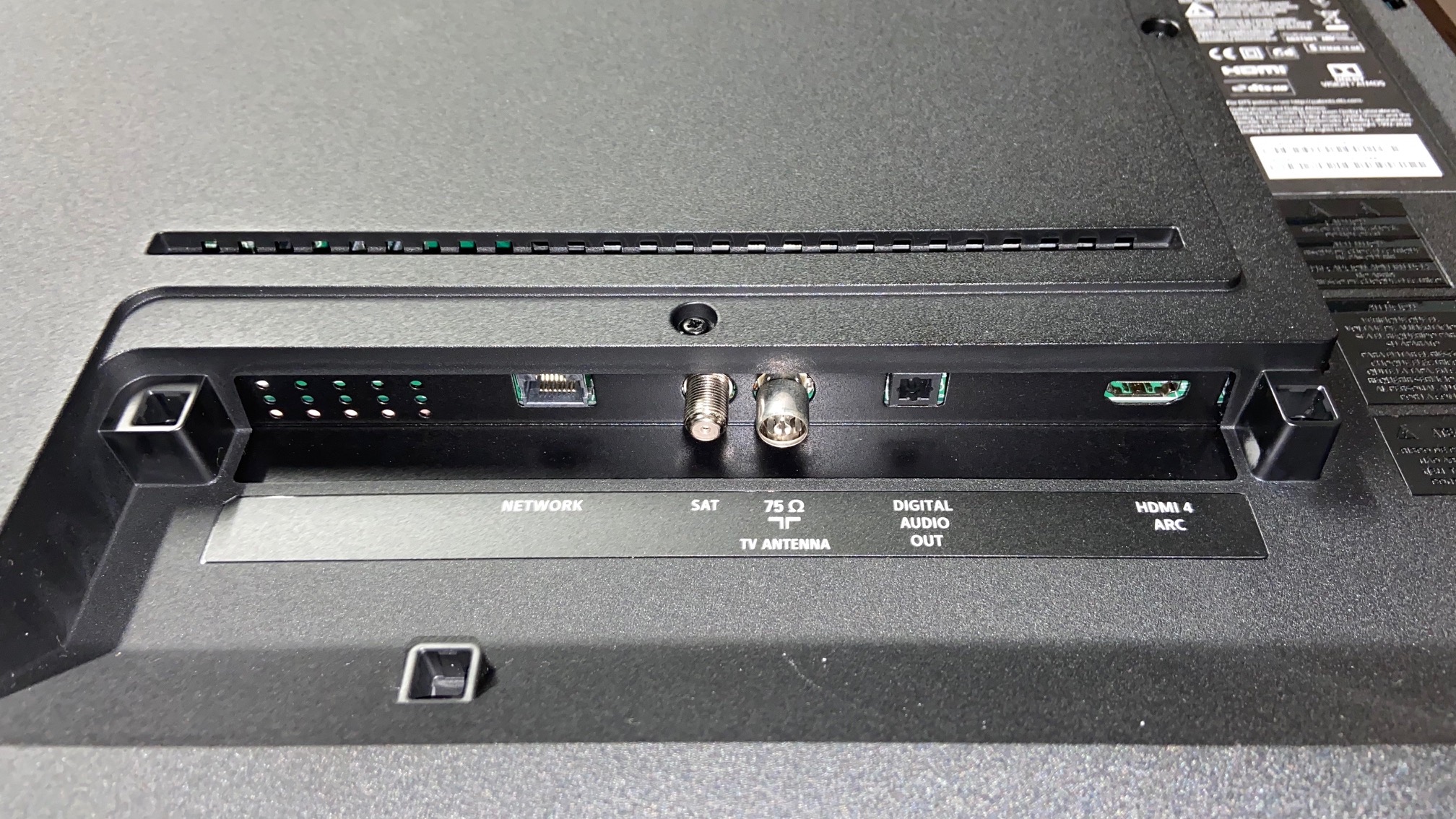
Smart TV (Android)
- Lots of content
- Relatively slick and stable Android TV implementation
- Android’s interface is still a bit clunky, and there’s no Apple TV
There was a time when Android TV’s cluttered interface, lack of customisation options, bugs, sluggishness and missing UK catch up apps made using it a pretty unpleasant experience. Philips, though, has long been better than other brands at making Android TV work, and this continues with the much-improved experience offered by the latest v9.0 Android TV implementation.
There’s practically no sluggishness now as you navigate around the home screen app and content shelves. Bugs are much rarer, as are lengthy app updates.
The system now supports at least a degree of customization, and isn’t so intent on pushing content at you that you really have no interest in watching.
It’s great, too, to find Philips now providing Freeview Play within the Android TV environment, meaning that you no longer have to worry about Android TV’s issues with supporting all the separate catch up apps for the UK’s key terrestrial broadcasters.
I still don’t find Android TV as easy to use, flexible or focussed as most other ‘in-house’, brand-specific smart TV systems. But it’s a million times better than it used to be, and there’s no doubt that it carries a vast quantity of apps and content. Including the key Netflix, Amazon Prime Video, Disney Plus, Freeview Play, Google Play Movies And TV and Rakuten TV streaming services. The only really major absentee is the Apple TV app.
Note, too, that since the 65OLED805 can play both the premium HDR10+ and Dolby Vision HDR formats, as well as the HLG format favoured by live broadcasters, you can get the best possible streaming performance from any service, regardless of which flavour of HDR it supports.
There’s built-in voice control using Google Assistant, or you can also use Alexa if you have an external Echo or similar device.
Finally, the Philips OLED 805 supports multimedia playback over network or from USB of a wide range of formats, including AVI, MKV, H264, MPEG-4 AVC, MPEG-1/2/4, WMV9/VCI, VP9, and HEVC H.265 videos; AAC music, MP3, WAV, WMA (v2 up to v9.2), and WMA-Pro audio files; and JPEG, BMO, GIF, PNG, 360 Photo and HEIF still image formats.
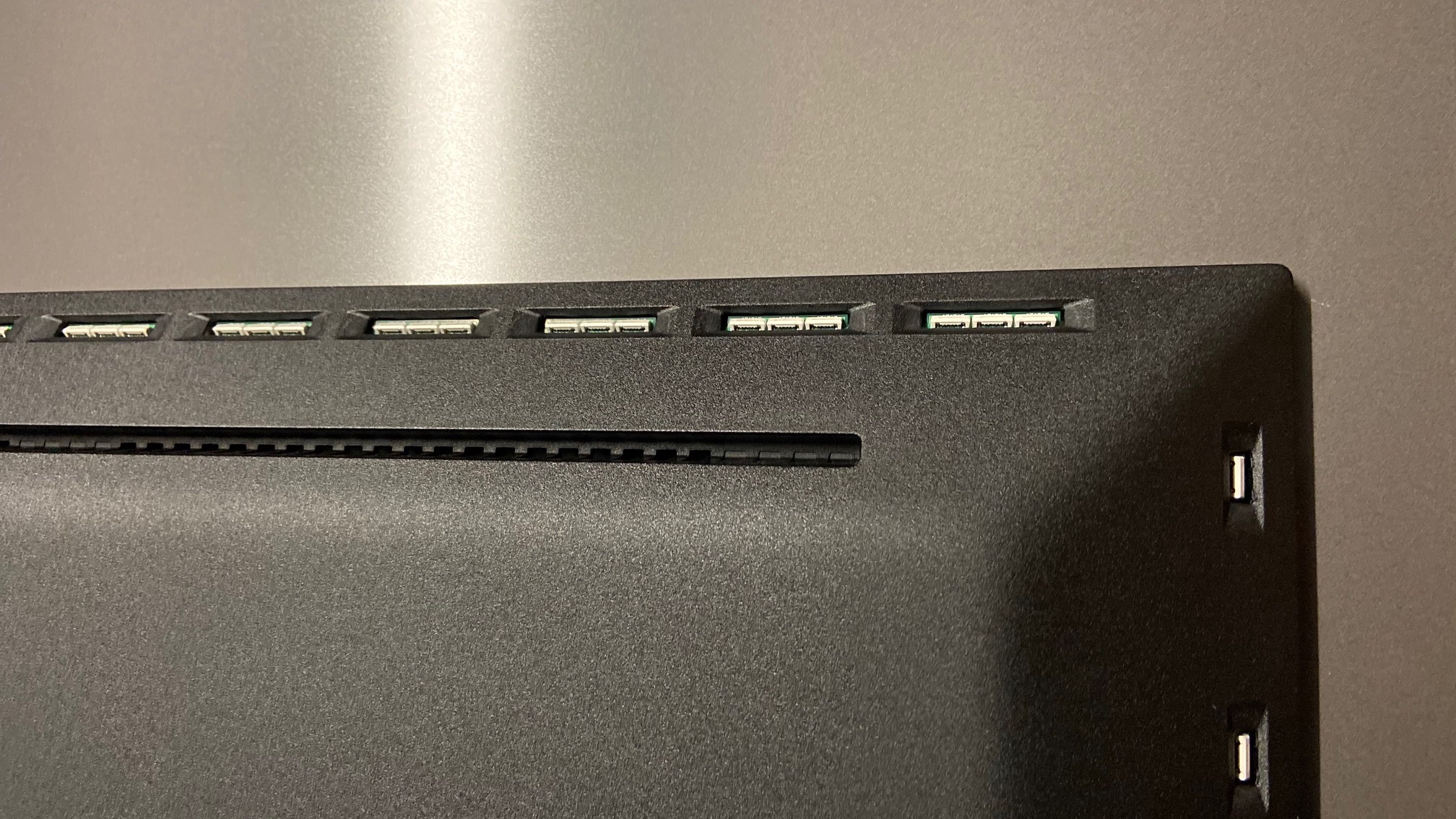
Picture quality
- Vibrant colours and lots of detail
- Exceptional handling of dark scenes
- Clever new motion processing
Most significant, here, is the boost the Philips OLED 805 receives to its video processing. The new fourth-generation P5 engine takes all the myriad picture enhancement steps introduced for last year’s third generation and introduces a key new AI element.
At the heart of this is the use of neural network technology to analyse a vast array of different image types and sources so that Philips’ latest TVs can more effectively classify incoming images and individual image elements. They’re now broken down into Nature, Face, Motion, Dark and ‘Other’ categories, enabling the TVs to more quickly and effectively apply the most effective processing to them.
The ‘Other’ category gets the same blanket processing as images on last year’s Philips sets, while the more specific categories are treated to new, refined processing algorithms. There’s even a new AI picture preset for both HDR and SDR sources, where the AI features are in play on top of the previous P5 picture processing elements.
The AI does actually apply to the other picture presets too, but with the specific AI mode you get dedicated minimum/medium/maximum adjustments for how intensely each AI element works. This is a welcome touch for AV fans who have their own image tastes, or who know that even the most advanced processors don’t always get everything right.
As with pretty much all the AI-based picture enhancements we’re seeing on TVs this year, the one in the Philips OLED 805 really makes a difference – and that difference is overwhelmingly positive.
The single most striking thing is how much more natural the new AI elements help pictures look. This may sound counter-intuitive, given that more rather than less computing power is being applied to the image. This extra processing power, though, is specifically being used to better recognise and handle different image and image object types – less likely to be plagued by processing-related issues such as overblown colours, forced detailing, blurry halos or flickering in areas of fast motion.
This is especially important in Philips’ case, since the brand has long had to accommodate some unwanted processing side effects to achieve its characteristically impactful pictures. Now, though, you can get that legendary Philips impact without nearly so many unwanted distractions.
The Philips OLED 805’s AI system combines with a general – and sensible – reduction in color saturation over last year’s models, producing refined and authentic-feeling colours right across the spectrum, in both dark and light scenes. Skin tones, in particular, look far more nuanced and consistently accurate than they’ve ever looked on a Philips OLED before.
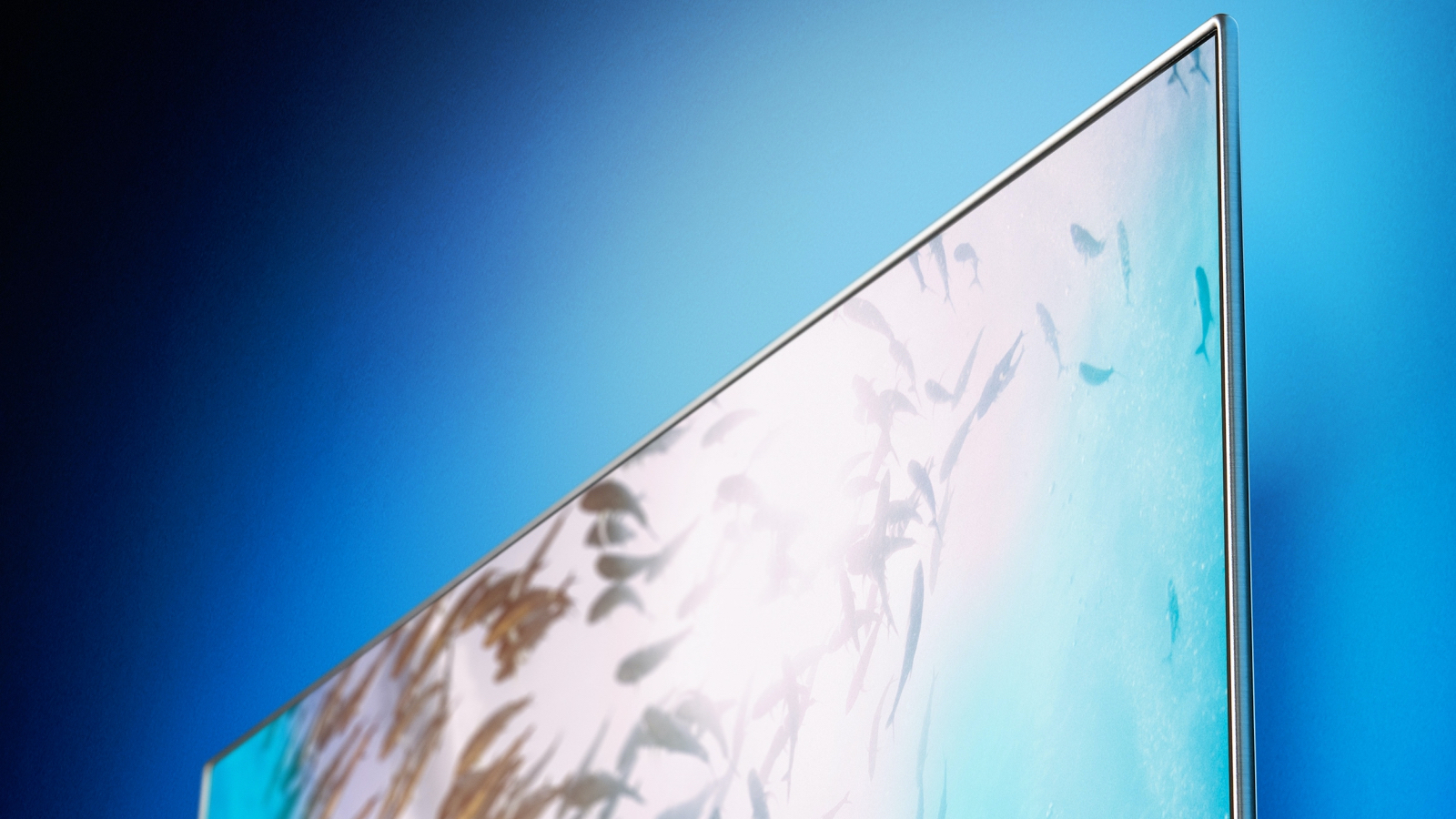
There’s a better balance to tones across the screen, too. Even though most of the set’s picture presets tend to dial up the color, this now applies in seemingly equal measure to each and every colour tone an image may contain. No tone looks out of place, and you take in the image as a beautifully vivid whole, rather than as a series of gaudy separate elements.
If the purist in you is bristling at this talk of amped up colours, don’t worry: Philips’ Movie preset provides a largely processing-free image designed to track SDR and HDR video standards. But I’m pretty confident many users will find the lure of other picture settings hard to resist.
Native 4K and upscaled HD pictures also look extremely crisp and detailed. The AI system adds precision and object-based finesse to Philips’ always impressive Ultra Resolution sharpness enhancer, meaning that – for the vast majority of the time – it enhances clarity without exaggerating source noise.
Nor does the sharpness have to take a hit when there’s a lot of motion in the image. Philips has introduced a couple of excellent changes to its always powerful ‘Perfect Motion’ processing this year: a refined Movie interpolation mode, and a new PureCinema mode. The former uses frame interpolation to reduce judder and blur, but on a low enough level to avoid processing artefacts and stop films succumbing to the dreaded, over-smooth ‘soap opera effect’.
PureCinema reorders the frame playback so that, say, a 24p movie contained in a 3:2 60Hz signal will be converted into a 5:5 cadence 120Hz signal – and it works brilliantly.
Bright HDR content reveals the 65OLED805’s pictures to be impressively bright too. This is confirmed by a measured peak brightness output of nearly 750 nits on a white HDR window covering 10% of the screen when using the HDR AI preset (though this drops to between 620 and 650 nits in the Personal and Natural picture presets, and 700 nits in Movie mode).
Philips’ handling of HDR, though, especially with AI preset, means images look much more intense than 750 nits with the sort of very small high brightness areas – reflections on metal, gleaming eyes, torches and so on – that help make HDR so lifelike and enjoyable. Because of this highlight ‘push’, the Philips OLED 805’s HDR brightness and impact is at least on a par with the LG CX.
Black levels, as usual with OLED TVs, are outstanding. There’s no hint of greyness in the darkest corners of the darkest scenes – yet there’s also no hint of reduced intensity for bright highlights against dark backgrounds. This is the single best thing, of course, about OLED’s self-emissive pixel technology.
It’s great to see, too, that there’s no instability in the Philips OLED 805’s exceptionally and consistently deep black reproduction, with minimal evidence of the noise or flashing issues sometimes caused by near-black content on OLED TVs.
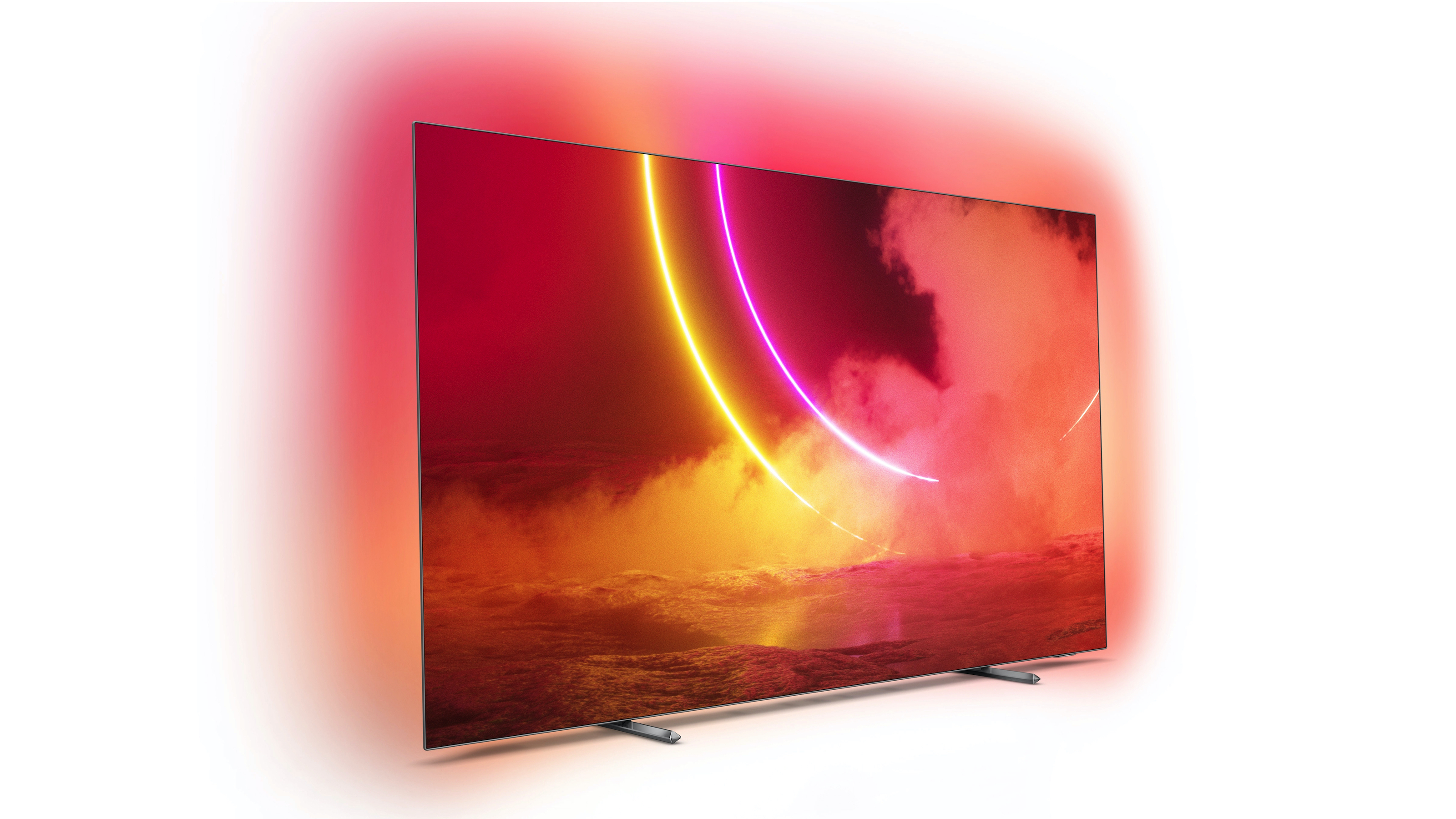
The new AI picture preset is particularly effective with HD, SDR content. It adds extreme sharpness and detail to sub-4K images, and typically handles grain and noise well as it does so. Occasionally a scene can look over-sharpened, a particularly grainy shot can have its grain exaggerated, or a peak highlight can look a little stressed. For the most part, though, it’s remarkable how well the Philips OLED 805 makes HD look like 4K.
Outside of the accurate Movie mode, the SDR handling boosts the luminance of SDR sources to create an exceptionally bright, colourful picture that looks almost HDR at times – without, again, typically looking forced or artificial.
The 65OLED805’s pictures aren’t quite perfect (inevitably). For starters, a little shadow detail can become lost in the darkest picture areas. Nudging the brightness up by one notch and/or reducing the Gamma setting by one step can help a little, though.
The minor black crush is less of an issue with Dolby Vision content, where the extra scene-by-scene data presumably helps the TV refine its shadow detail resolution.
While the HDR AI mode is generally very smart about what it does, it can cause scenes containing a lot of detail and motion to lose resolution. The start of Chapter 2 of Blade Runner 2049 on 4K Blu-ray, where K returns in his Spinner to a misty city, finds the city looking noticeably soft and even a bit smeary in the HDR AI mode. Shifting the AI mode’s Source Perfection option from the default Medium setting to Minimum brings much of the detail back, but the results still aren’t quite as satisfying as they can be in, say, the HDR Personal preset. I also found I could get slightly more natural-looking motion using the options available in non-AI modes than I could with the AI mode’s simple Min, Med and Max settings.
Faint vertical banding appeared during one or two dark – usually dark grey – sequences, including, again the BR2049 city approach in Blade Runner 2049. The Philips OLED 805’s screen is quite reflective of lights in your room, too, and there can be some slight colour banding in areas of subtle HDR colour blending.
Finally, Philips’ step up OLED model for 2020, the Philips OLED+935, delivers noticeably better pictures thanks to its use of an even more powerful image processing system. Look out for a review of this TV soon.
None of this alters the fact, though, that the Philips OLED 805 is a brilliant performer for its money that combines Philips’ taste for bold pictures with a whole new level of AI-inspired refinement.
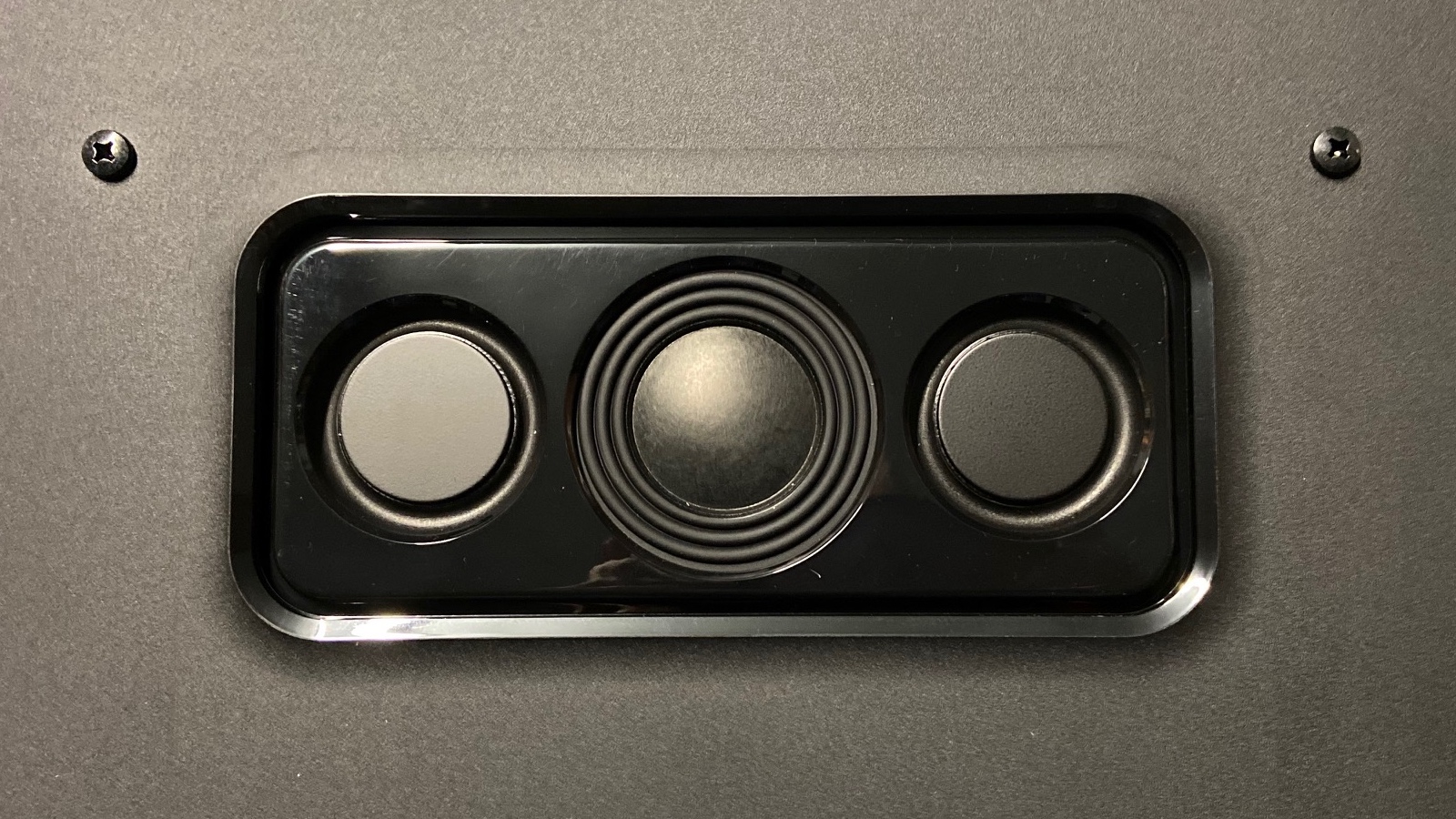
Audio performance
- Detailed and clean Dolby Atmos playback
- Believable, distortion-free dialogue
- Limited height effects and bass
The Philips OLED 805’s exceptionally sturdy build quality and three substantial open-speaker drivers on its rear contribute to a surprisingly satisfying audio performance.
The sound disperses nicely to left and right, travelling far beyond the screen’s physical boundaries without losing cohesion or detail. In fact, detailing is very impressive for a TV that doesn’t boast any forward-facing speakers.
The mid-range is expansive and dynamic, too, and voices emerge clearly even when there’s all kinds of racket going on behind them.
Thanks to these qualities, the Philips OLED 805 gets decent value from its built-in Dolby Atmos decoder. There are, though, inevitably limits to its Dolby Atmos skills. There isn’t much of a sense of height, for instance, and while bass is clean and lively, it doesn’t attempt to plumb any great low frequency depths. This is preferable to the sort of crackly, thuddy mess you can get when TVs try to deliver more bass than their woofers can sensibly handle, though.
Should I buy the Philips 65OLED805?
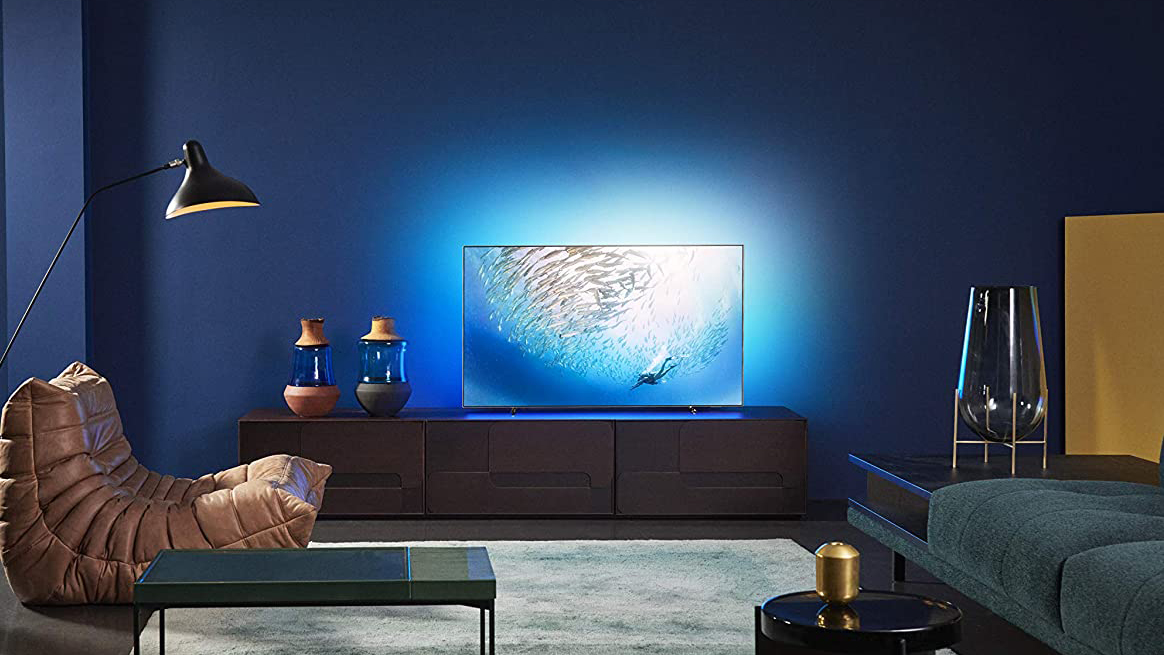
Buy it if...
You want the best value OLED TV in town
Despite boasting a strong roster of features and an excellent all-round performance, the 65OLED805 is at the time of writing substantially cheaper than any of its closest 2020 rivals.
You want a TV that’s a real design statement
As well as being beautifully built, the 65OLED805’s sleek design is set off by the light show extravaganza of Philips’ unique Ambilight technology.
You want full HDR support
Philips has decided to ignore industry politicking by supporting all the main HDR formats out there – HDR10, HLG, HDR10+ and Dolby Vision –meaning you’ll always get the best picture whatever you watch.
Don't buy it if...
You aren’t prepared to take a little care over what you watch
OLED TVs are susceptible to permanent image retention if you don’t take some care over how much you watch content with static image content, such as channel logos.
You have a very bright room
While the 65OLED805’s pictures are actually quite bright and rich by OLED standards, its reflective screen and relative lack of brightness versus premium LCD TVs are worth bearing in mind if your living room is typically filled with ambient or artificial light.
You’re a fan of trigger-response gaming
While the 65OLED805’s 33ms of input lag in its game mode is hardly bad, it is 20ms or more above what we’re seeing from a number of big-name rival LCD and OLED TVs this year.
- Check out the best TVs in the UK
John has been writing about home entertainment technology for more than two decades - an especially impressive feat considering he still claims to only be 35 years old (yeah, right). In that time he’s reviewed hundreds if not thousands of TVs, projectors and speakers, and spent frankly far too long sitting by himself in a dark room.
